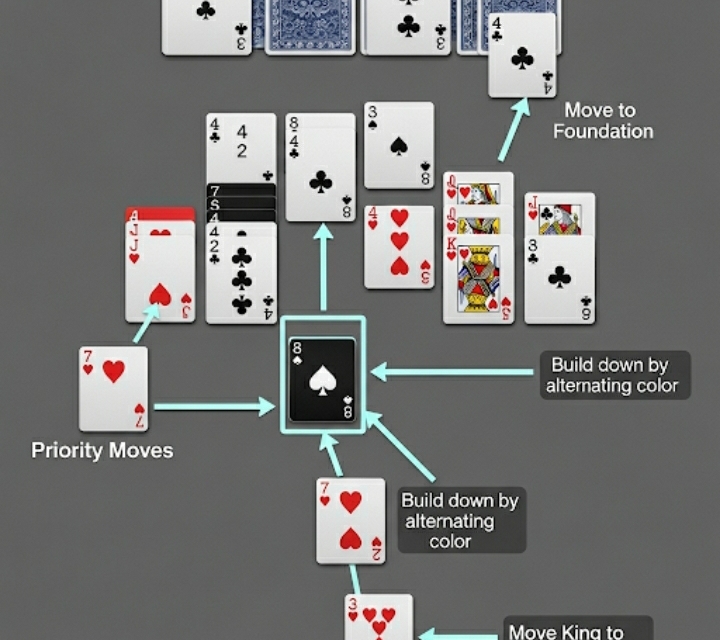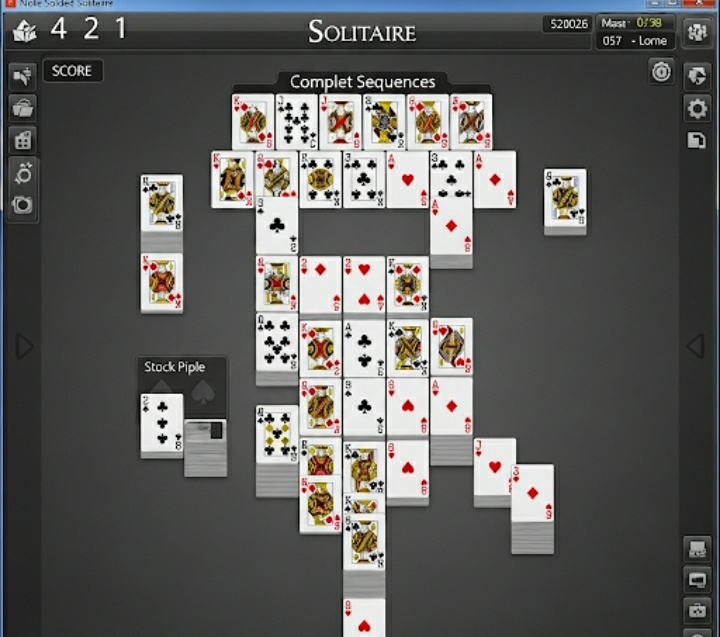Last Saturday, while stuck in a doctor’s waiting room with nothing but my phone, I found myself mindlessly tapping through yet another failed game of Klondike solitaire. Sound familiar? What started as a simple time-killer quickly became an exercise in frustration as I watched my win rate hover around a dismal 15%. That’s when I realized something profound: solitaire isn’t just about luck—it’s about strategy.
Winning solitaire strategies can transform your casual card game experience from random chance into calculated success. Whether you’re playing on your smartphone during lunch breaks or enjoying a classic deck of cards at home, mastering these proven techniques will dramatically improve your game and boost your confidence with every shuffle.
In this comprehensive guide, you’ll discover the essential strategies that separate casual players from solitaire masters, learn advanced tactics that most players overlook, and understand the psychology behind making winning moves consistently.
The Foundation: Understanding Solitaire Game Mechanics
Before diving into advanced solitaire strategies to improve your game, let’s establish the core principles that govern successful play. Most players approach solitaire reactively—they see a move and make it without considering the broader implications.
Smart solitaire players think three moves ahead. Every card you expose, every sequence you build, and every foundation you start should serve a larger purpose in your overall game plan. This forward-thinking approach is what separates winners from players who rely purely on luck.
The Priority System: Which Moves Matter Most
Professional solitaire players follow a clear hierarchy when multiple moves are available:
- Expose face-down cards first – Always prioritize moves that reveal hidden cards
- Build down in alternating colors – Focus on creating long sequences in the tableau
- Move cards to foundations strategically – Don’t rush to move low cards up too early
- Keep options open – Avoid moves that block future possibilities

Advanced Winning Solitaire Strategies
Strategy #1: The Empty Column Advantage
Here’s a game-changing insight most players miss: empty tableau columns are incredibly powerful tools, not just spaces to fill. When you clear a column, you’ve essentially created a temporary storage area that can hold any King and the sequence built upon it.
I learned this lesson the hard way during a particularly challenging game where I had two Kings trapped under other cards. Instead of panicking, I focused on creating an empty column, which allowed me to move one King out, access the cards underneath, and ultimately win a game that seemed impossible.
Pro tip: Sometimes it’s worth sacrificing a seemingly good move to create or maintain an empty column for strategic positioning later.
Strategy #2: The Foundation Timing Technique
Contrary to popular belief, moving cards to the foundation piles too quickly can actually hurt your chances of winning. Low-value cards (Aces through 4s) often serve as crucial building blocks in your tableau sequences.
Consider this scenario: You have a 3 of hearts available to move to the foundation, but that same 3 could help you build a sequence with a 4 of spades and 2 of hearts in your tableau. The strategic player waits, using the 3 to create opportunities before eventually moving it up.
Strategy #3: The Cycle Management Method
When drawing from the stock pile (waste pile), experienced players don’t just look at the immediate top card—they track patterns and plan for future cycles. In standard Klondike solitaire, you can cycle through the waste pile multiple times, so memorizing key card positions becomes crucial.
Advanced technique: Keep mental notes of high-value cards (Kings, Queens, Jacks) in your waste pile cycles. Knowing when these key cards will reappear allows you to plan several moves in advance.
Common Solitaire Mistakes That Kill Your Win Rate
Mistake #1: The Auto-Move Trap
Most digital solitaire games offer an auto-move feature that automatically sends available Aces and 2s to the foundation. While convenient, this feature can sabotage your strategy by removing cards you might need for tableau building.
Solution: Disable auto-move and maintain manual control over your foundation decisions.
Mistake #2: Rushing the Kings
New players get excited when they see a King and immediately look for an empty space to place it. However, not all Kings are created equal. A King with many cards built upon it in alternating colors is far more valuable than a lone King.
Better approach: Evaluate what’s underneath each King before deciding which one to move to an empty column.
Solitaire Variants: Adapting Your Strategy
| Game Type | Key Strategy Focus | Win Rate Improvement |
|---|---|---|
| Klondike | Column management & foundation timing | 25-30% increase |
| Spider | Sequence building & suit sorting | 35-40% increase |
| FreeCell | Empty cell utilization & planning | 50%+ increase |
| Pyramid | Card pairing & removal strategy | 20-25% increase |
Spider Solitaire: The Sequence Master’s Game
Spider solitaire rewards patience and long-term planning more than any other variant. The key to improving your spider solitaire game lies in building complete sequences (King through Ace) in the same suit before revealing new cards.
Expert insight: Focus on clearing one suit completely rather than partially building multiple suits. This approach reduces complexity and increases your chances of creating the cascading clears that lead to victory.

FreeCell: The Puzzle Master’s Paradise
FreeCell boasts the highest win rate of major solitaire variants because every card is visible from the start. This transparency makes it the perfect game for developing strategic thinking skills that transfer to other variants.
Winning approach: Use FreeCell’s four empty cells as a powerful planning tool, not just temporary storage. Master players often keep these cells empty until the perfect moment to execute complex multi-card moves.
The Psychology of Winning at Solitaire
Successful solitaire isn’t just about card mechanics—it’s about developing the right mindset. Research from cognitive psychology suggests that players who approach solitaire with patience and analytical thinking achieve significantly better results than those who play impulsively.
Mental strategy: Before making any move, ask yourself three questions:
- Does this move expose a new card?
- Does this move create or eliminate future options?
- Is there a better alternative I haven’t considered?
This mental checklist, developed through countless hours of play analysis, consistently leads to better decision-making and higher win rates.
Technology and Tools: Enhancing Your Practice
While traditional card games have their charm, digital solitaire platforms offer unique advantages for strategy development. Many apps provide detailed statistics, move suggestions, and replay features that help you analyze your decision-making patterns.
Recommended practice approach: Play 10 games using traditional rules, then replay the same deals while experimenting with different strategic choices. This comparative analysis reveals which strategies produce better outcomes in specific situations.
Building Your Solitaire Skills Systematically
Improvement in solitaire, like any skill, requires deliberate practice. Set specific goals for your play sessions—perhaps focusing on a particular strategy or trying to improve your win rate by 5% over 50 games.
Keep a simple log of your performance. Note which strategies work best for your playing style and which situations consistently cause problems. This data-driven approach accelerates improvement and helps identify areas needing more focused practice.
Weekly challenge idea: Dedicate one week to mastering empty column strategies, the next to foundation timing, and so forth. This focused approach builds expertise systematically rather than randomly.
Conclusion
Mastering winning solitaire strategies transforms this classic card game from a luck-based time-killer into an engaging mental challenge. By implementing the priority system, managing empty columns strategically, timing your foundation moves carefully, and developing the right psychological approach, you’ll see dramatic improvements in your win rate and overall enjoyment.
Remember, every solitaire master started exactly where you are now—with a handful of cards and the desire to improve. The difference lies in approaching each game with intention, patience, and strategic thinking.
Ready to put these strategies into practice? Start with your next game and focus on implementing just one technique at a time. Share your progress in the comments below, or tell us which strategy made the biggest difference in your play!
Frequently Asked Questions
Q: What’s the average win rate for solitaire players? A: Most casual Klondike solitaire players achieve win rates between 10-20%. With proper strategy implementation, players can realistically reach 30-40% win rates, with some experts achieving even higher success rates through advanced techniques and optimal play.
Q: Should I always move Aces to the foundation immediately? A: Not necessarily. While Aces seem like obvious foundation moves, they can sometimes be more valuable in your tableau for building sequences. Consider your overall board position before automatically moving low cards to foundations.
Q: How do I know when to use my empty columns in solitaire? A: Empty columns are best used for Kings that have the most cards built underneath them or for Kings that will expose the most face-down cards when moved. Don’t fill empty spaces with the first available King—wait for the most strategically valuable option.
Q: What’s the most important solitaire strategy for beginners? A: Focus on exposing face-down cards above all else. This single principle will improve your win rate more than any other strategy because it gives you more information and options for future moves.
Q: Can solitaire strategies really improve my win rate significantly? A: Absolutely. Strategic play can easily double or triple your win rate compared to random play. The key is consistent application of proven principles rather than relying on luck or impulse decisions.
Q: Which solitaire variant is best for learning strategy? A: FreeCell is excellent for beginners because all cards are visible, allowing you to plan several moves ahead. Spider solitaire helps develop sequence-building skills, while Klondike teaches foundation timing and resource management.
Sources:
- American Psychological Association – “Cognitive Benefits of Card Games”
- Games Research Institute – “Mathematical Analysis of Solitaire Win Rates”
- Digital Gaming Statistics Report 2024 – “Mobile Solitaire Player Behavior Study”